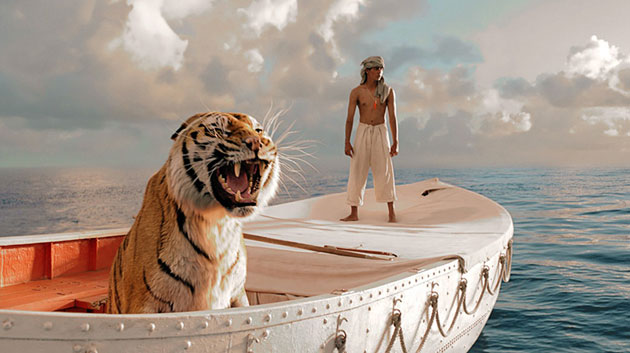Life of Pi is a highly decorated and successful novel by Yann Martel which won the Man Booker Prize in 2003, sold millions of copies worldwide and has admirers including Barack Obama. But since I’m a poorly read shlub who doesn’t keep up with these sort of things, the first time this story caught my attention was when Ang Lee’s production studio released the image above promoting the film adaptation that is due out later this year. The image of an Indian boy standing shirtless on a boat next to a giant tiger bearing his teeth stirred my imagination. I had no idea what the story was about but I thought it was a cool looking picture. Would The Life of Pi be a story obsessed with beautiful imagery like Tarsem Singh’s film The Fall? Or perhaps it would be a tale of adventure that was evocative of Sinbad the Sailor?
Having picked up the book and finished it from cover to cover, I can tell you it is neither of these things. Life of Pi is a strange, spiritual and quite wonderful book. Though I’m an atheist, I’m broadminded enough that I can get invested in the story of an earnest young Indian boy named Piscine Patel who is so interested in exploring his spirituality in his adolecense that he ends up practising not one but three religions simultaneously. Pi identifies himself as a Hindu, Christian and Muslim. After a short introduction where the author Yann Martel is introduced to Life of Pi‘s narrator, the story begins in an Indian zoo in the Seventies where Piscine ‘Pi’ Patel and his family decide to move abroad to Canada to avoid political unrest. The family travel via a Japanese freighter which sinks, drowning everyone on board except Pi who scrambles onto a lifeboat that is occupied by an orangutan, a zebra, a hyena and a tiger.
What follows is an unusual and protracted survival story. Pi is a well spoken and optimistic narrator but gradually the animals turn on one another and he becomes consumed with doubt, fear and mental fatigue as he spends days, weeks and months out at sea with only animals for company.
The book’s second act, which details Pi’s attempts at surviving and forming a relationship with the bengal tiger (curiously named Richard Parker) is an interesting and absorbing read. Partly for the vivid way in which Martel describes Pi’s gradually diminishing physical and mental health and also for the increasingly bizarre events that happen late in the tale. Martel has an excellent way with words which give real life to the text. Take for example his way of describing the amount of escaped wildlife in big cities. “If you tipped Tokyo upside down, you’d be surprised how many badgers, giraffes and crocodiles fall out.” I like that.
If that were all there was to Life of Pi I think the book would still be easy to recommend, should the mood take you to read a survival story. However, the kicker is in the third act when Martel plays his hand in a way which I will not spoil. I don’t think its something I could count as a ‘twist.’ What happens in the third act simply gives greater depth, context and room for interpretation to the events that precede it and it is only then that you see how well crafted this tale really is. Everything from the choice of animals, Pi’s belief in different faiths and even his name are all chosen with a purpose in mind.
I eagerly await the film in November and in the meantime, I give this book my heartiest recommendation. Entertaining, imaginative and thought provoking.
 The FAT Website est. 1999
The FAT Website est. 1999



